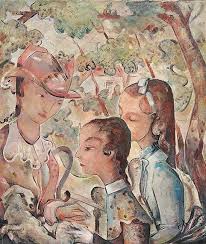Joseph Koelschbach
Joseph Kölschbach , also: Josef (born April 18, 1892 in Cologne ; died August 6, 1947 in Rhöndorf ) was a German expressionist painter.
Life
Joseph Kölschbach began studying at the Düsseldorf Art Academy in 1912 . After visiting the exhibition of the Sonderbund Westdeutscher Kunstfreunde und Künstler in Cologne in 1912 , he broke off his studies and became a freelance artist. He met August Macke through Max Ernst , who invited him to the exhibition of Rhenish Expressionists in Bonn . Kölschbach presented several reverse glass pictures and several compositions there. In Reiff Museum Aachen after he had a solo exhibition. Macke also ensured his participation in the First German Autumn Salon in 1913 in Herwarth Walden's Sturm-Galerie in Berlin , where he exhibited a composition and a nude composition, while twelve reverse glass pictures broke during the transport to Berlin. Franz Marc praised Kölschbach's “small” pictures to the critical co-organizer Wassily Kandinsky . In 1914, Kölschbach took part in the Cologne Werkbund exhibition with designs for stained glass windows and paintings .
From 1914 to 1916 he was a soldier in the First World War , after being injured in the war he was a temporary assistant teacher at the Cologne School of Applied Arts . In 1918 he took part in the exhibition The young Rhineland in the Cologne Art Association and in 1919 in the artists' association Der Strom . Until 1933 he traveled regularly to Paris and cultivated his artist friendship with Max Ernst. In 1927 he married the dance and gymnastics teacher Anna Müller-Herrmann and now worked in Berlin.
After the handover of power to the National Socialists in 1933, his pictures were considered degenerate and in 1937 they were confiscated from German museums. Kölschbach reacted to the political repression with depression, and there was also the fact that he was bombed twice in Berlin in 1944. After the end of the war he returned to Cologne in 1945.
Kölschbach died in 1947 at the age of 55 and was buried in the family grave at the Melaten cemetery in Cologne (hallway 8 (R1)).
Works / exhibitions
As of 2013, there is no catalog raisonné of Kölschbach . It is also not listed in the current AKL .
literature
- Irene Kleinschmidt-Altpeter: Joseph Kölschbach , short biography, in: Stephan Berg (Ed.): An Expressionist Summer, Bonn 1913 , catalog of the exhibition. Munich: Hirmer 2013
Individual evidence
- ↑ a b c d Irene Kleinschmidt-Altpeter: Joseph Kölschbach , short biography, 2013, p. 58
- ↑ August Macke, letter to Walden on February 19, 1913, in: Andreas Hüneke (ed.), The blue rider: Documents of a spiritual movement . Reclam, Leipzig 1986, p. 449
- ^ First German Autumn Salon. Berlin 1913 . Berlin: Verl. Der Sturm, 1913, p. 22
- ↑ Franz Marc, letter to Kandinsky on September 30, 1913, in: Andreas Hüneke (Ed.), The blue rider: Documents of a spiritual movement . Reclam, Leipzig 1986, p. 480
- ↑ Irene Kleinschmidt-Altpeter: Joseph Kölschbach , 2013, p. 58. Kölschbach is not included in the database maintained by the Free University of Berlin : Confiscation inventory “Degenerate Art” , at FU Berlin, search query on January 18, 2015
- ↑ Irene Kleinschmidt-Altpeter: Joseph Kölschbach , 2013, p. 142
| personal data | |
|---|---|
| SURNAME | Koelschbach, Joseph |
| ALTERNATIVE NAMES | Koelschbach, Josef |
| BRIEF DESCRIPTION | German expressionist painter |
| DATE OF BIRTH | April 18, 1892 |
| PLACE OF BIRTH | Cologne |
| DATE OF DEATH | August 6, 1947 |
| Place of death | Rhöndorf |


